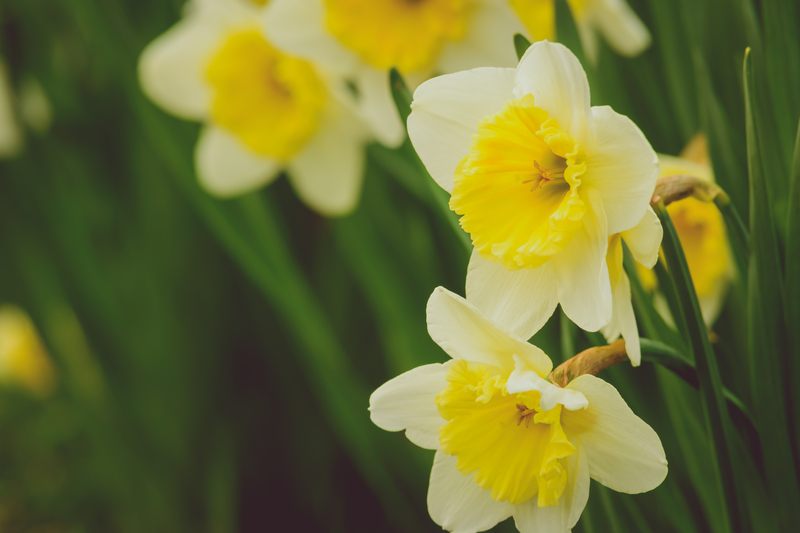Container gardening: A guide to urban farming
Posted on 14/08/2025
Container Gardening: A Guide to Urban Farming
Urban dwellers face unique challenges when it comes to growing their own food or cultivating a garden. Container gardening, also known as urban container farming, offers a practical, flexible, and rewarding solution. Whether you live in a high-rise apartment, a townhouse with a small courtyard, or simply crave a green oasis on your balcony, this comprehensive guide to container gardening will help you get started and thrive. Dive in to discover effective techniques, plant selection tips, care advice, and creative inspiration for your own urban farming adventure.
What is Container Gardening?
Container gardening is the art and science of growing plants--flowers, herbs, fruits, or vegetables--in containers rather than directly in the ground. These containers can be anything from traditional pots and planters to recycled buckets, wooden crates, grow bags, or even old bathtubs. This method is ideal for small-space gardening, making it perfect for city dwellers who want to practice urban agriculture without the need for a traditional garden plot.

Benefits of Container Gardening in Urban Spaces
- Space Efficiency: Perfect for balconies, rooftops, patios, and even windowsills.
- Portability: Move your plants to capture optimal sunlight or protect them from inclement weather.
- Pest and Disease Control: Easier to monitor and manage compared to in-ground gardens.
- Flexibility: Grow a variety of crops, flowers, and herbs year-round regardless of soil conditions.
- Accessibility: Ideal for gardeners of all ages and mobility levels; containers can be raised to reduce bending and strain.
- Urban Greening: Beautifies urban settings, improves air quality, and contributes to sustainability efforts.
Essential Elements of Successful Container Gardening
For a thriving urban container garden, attention to several key elements is crucial. These include the selection of the right containers, quality soil, appropriate lighting, proper watering, and the choice of plants suited for the urban environment.
Choosing the Right Containers
Containers come in all shapes, sizes, and materials. To ensure the best results in urban farming with containers, consider these factors:
- Size: Select containers large enough to accommodate the root systems of your plants. Deeper pots are suitable for root vegetables; shallow ones suit herbs and leafy greens.
- Material: Clay and terracotta offer breathability but dry out quickly; plastic is lightweight and retains moisture; wooden planters provide insulation but may rot over time.
- Drainage: Ensure all containers have adequate drainage holes to prevent waterlogging and root rot.
- Mobility: Consider how easily you can move the containers, especially if you need to follow the sun's path.
Soil and Potting Mix
Unlike traditional garden soil, container gardening soil needs to provide optimal drainage, aeration, and nutrients. Use a high-quality potting mix instead of yard soil, as it is formulated to support plant health in enclosed spaces. You can further enrich your mix with organic compost, perlite, or vermiculite.
Light and Location
Most edible crops and flowering plants require at least 6 hours of direct sunlight per day. Assess your available spaces--balconies, windowsills, or rooftops--and select locations with sufficient light. If sunlight is limited, especially indoors, consider investing in grow lights tailored for container gardening.
Watering Techniques
Containers tend to dry out faster than garden beds, especially during hot weather. Consistent, moderate watering is key. Below are some essential watering tips:
- Frequency: Check soil moisture daily, especially in summer. Water when the top inch feels dry.
- Technique: Water deeply to encourage roots to grow downward; avoid overwatering to prevent root rot.
- Mulching: Add mulch on the surface to retain moisture and suppress weeds.
Fertilization and Nutrient Management
Plants in containers rapidly deplete available nutrients. Regular fertilization using a balanced, slow-release fertilizer or organic compost is crucial for sustaining healthy growth. Remember, leafy greens need less fertilizer compared to fruiting plants like tomatoes or peppers.
Best Plants for Container Gardens
Not all plants are equally suited to life in a pot. Choose container-friendly vegetables, herbs, and flowers that match your local climate, container size, and light levels. Some popular and easy-to-grow options include:
Edible Crops
- Herbs: Basil, mint, parsley, chives, cilantro, rosemary, thyme, and oregano thrive in containers and provide fresh flavor for your meals year-round.
- Leafy Greens: Lettuce, spinach, kale, arugula, and Swiss chard grow quickly and are ideal for small spaces.
- Compact Vegetables: Cherry tomatoes, bush beans, dwarf peppers, radishes, carrots, and baby eggplants are well-suited for pots.
- Root Vegetables: Choose varieties bred for container growth, such as short carrots, baby beets, or round radishes.
- Fruits: Strawberries, dwarf blueberries, bush cucumbers, and even certain varieties of figs or citrus can thrive in larger containers.
Ornamental Plants and Flowers
- Annuals: Petunias, marigolds, pansies, and impatiens add vibrant color and attract pollinators.
- Perennials and Shrubs: Lavenders, dwarf roses, heucheras, and small hydrangeas work beautifully in larger pots.
- Vertical Gardening: Use trellises or hanging baskets to grow climbing beans, peas, trailing nasturtiums, or morning glories for a lush look and more efficient use of space.
Design Ideas for Urban Container Gardens
A container garden can be as practical as a mini vegetable patch or as artistic as a living wall. Here are some inspiring ways to maximize your urban growing area:
- Vertical Gardening: Use wall-mounted pots, shelves, ladders, or stackable containers to grow upwards and make the most of limited floor space.
- Mixed Plantings: Combine edible and ornamental plants for beauty and functionality--imagine tomatoes growing alongside marigolds or basil nestled among petunias.
- Themed Containers: Create sensory gardens (fragrant herbs, tactile foliage), salad tubs, or cocktail-themed planters (mint, lemon balm, strawberries).
- Mobile Gardens: Add casters or wheels to heavy containers to easily adjust garden layout, move plants for sun exposure, or shelter them during storms.
Step-by-Step Guide to Starting Your Container Garden
1. Plan Your Space
- Assess sunlight, wind, and microclimates in your available area.
- Measure dimensions of balconies or patios to determine how many containers will fit comfortably.
- Consider your goals: Do you want fresh herbs, vegetables, or simply decorative greenery?
2. Choose Suitable Containers
- Use recycled materials for sustainability or select stylish planters for a designer look.
- Ensure all containers have adequate drainage holes.
- Match container size to the mature size of your chosen plants.
3. Prepare Your Potting Mix
- Use lightweight, fast-draining potting soil suited for container gardening.
- Add compost or organic matter to enrich nutrients.
- Fill containers, leaving a two-inch space from the rim to prevent overflow when watering.
4. Select and Plant
- Group plants with similar sunlight and moisture needs together for easier care.
- Follow planting depth and spacing guidelines for each species.
- Water thoroughly after planting to help settle the soil and eliminate air pockets.
5. Maintain and Monitor
- Check for pests and diseases regularly; healthy soil and proper drainage will minimize issues.
- Fertilize as needed during the growing season--usually every 2-4 weeks depending on plant type.
- Rotate and prune plants as they grow to maintain shape and maximize yield.
Troubleshooting Common Container Gardening Problems
Like any form of gardening, urban container gardens come with a few challenges. Here are solutions to common issues:
- Yellowing leaves: Often caused by overwatering, poor drainage, or nutrient deficiencies. Check soil moisture and fertilize appropriately.
- Wilting plants: Typically a result of underwatering or extreme heat. Water more frequently and provide afternoon shade.
- Pests (aphids, mites, slugs): Hand-pick pests, use organic sprays, or introduce beneficial insects like ladybugs.
- Leggy growth: Plants stretching towards light indicate insufficient sunlight; move containers to a brighter location.
- Root-bound plants: Repot in larger containers if roots crowd the edges or emerge from drainage holes.
Urban Container Gardening Tips for Maximum Yield
- Succession Planting: Replace harvested crops with new plants for continuous production.
- Companion Planting: Grow crops together that benefit each other, such as basil with tomatoes or marigolds with beans.
- Smart Watering: Use self-watering containers or drip irrigation systems to reduce workload and conserve resources.
- Season Extension: Use cloches, row covers, or bring containers indoors to stretch your growing season.
- Frequent Harvesting: Regular picking encourages more growth, especially with herbs and salad greens.
Sustainability and Community Aspects of Urban Container Farming
Container gardening not only provides fresh produce but also contributes to sustainable living in the city:
- Reduces food miles and packaging waste by growing fresh food at home.
- Improves biodiversity in urban spaces by attracting pollinators and beneficial insects.
- Uses upcycled materials and organic practices to minimize environmental impact.
- Fosters community through shared balconies, rooftop gardens, or neighborhood container garden projects.

Resources to Enhance Your Container Gardening Journey
- Online forums and gardening apps (such as GardenTags, GrowIt!, or Reddit's container gardening community) provide advice and inspiration.
- Local nurseries and garden centers often carry plants and supplies ideal for urban farming.
- Workshops and classes on balcony gardening, composting, or indoor plant care offered by extension offices or community gardens.
- Books and websites specializing in small-space and container gardening offer advanced tips and project ideas.
Final Thoughts: Flourish with Urban Container Gardening
Container gardening opens up a world of possibilities for urbanites yearning for green spaces and homegrown food. This form of urban farming is accessible, eco-friendly, and adaptable to virtually any lifestyle or living arrangement. With thoughtful planning, smart plant selection, and regular care, you can transform balconies, patios, rooftops, or even windowsills into vibrant, productive micro-gardens.
Embrace the joys of urban container growing--connect with nature, boost your well-being, and harvest fresh flavors right outside your door. Your urban vegetable garden or flower-filled city oasis awaits. Get started today, and experience the transformative power of container gardening in the urban landscape!

